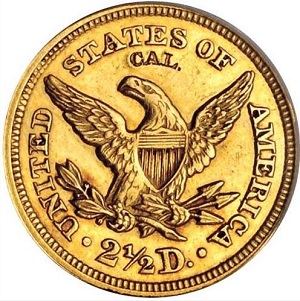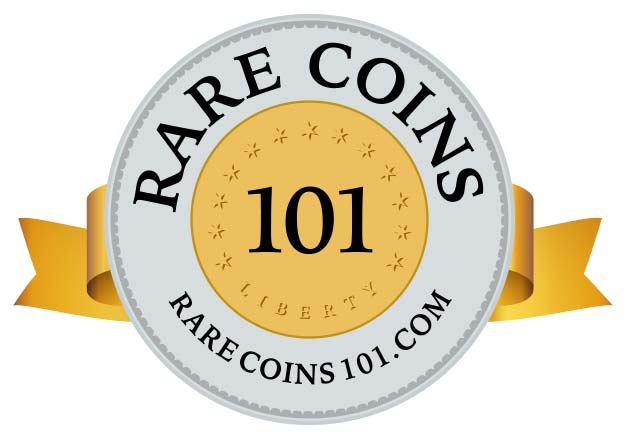1848 Coronet $2.50 Quarter Eagle, CAL.
Gold was discovered at Sutter’s Mill near Coloma, California on January 24, 1848. The find set off a mass migration of fortune seekers to the American West.
On December 9, 1848, a special shipment of 228 ounces of California gold arrived in Washington DC, sent by the acting governor of California, Colonel R.B. Mason. The Secretary of War, William L. Marcy, forwarded the gold to the Philadelphia Mint, along with a handwritten message suggesting this particular shipment of gold be made into quarter eagles bearing a distinguishing mark on each.(1)
Mint Director Robert M. Patterson arranged to have the mark added to a small quantity of 1848 quarter eagles by utilizing a simple punch. The lettering “CAL.” was stamped on the reverse, above the eagle’s head. The CAL. letters were intended to indicate the coin was made from California gold.
Most experts are convinced that each CAL. coin was punched while still seated in the die, because there is no detectable obverse damage on any known examples.
Fascinating Fact: Almost from the moment the CAL. quarter eagle was first made, unscrupulous individuals have tried to cash in on its fame by fabricating their own “CAL.” punch and stamping it into ordinary 1848 quarter eagles from Philly. There was only a single “CAL.” punch officially used by Mint workmen, and counterfeiters never have duplicated the exact lettering of authentic specimens (location of the punch compared to other reverse details varies, so this cannot be used to determine legitimacy). Another telltale indicator of fakery is flattening on the obverse side – occurring as pressure was applied to the bogus punch while stamping the reverse.(2)
An estimated 1,389 of the 1848 CAL. Coronet quarter eagles were minted. Coin collectors of today hold this coin in high esteem. Not only is it a coveted rarity, its origins are directly linked to one of the most important episodes in American history, the California Gold Rush. As a doubly significant coin, the 1848 CAL. quarter eagle rightfully merits a home in the pantheon of numismatics.
| Estimated survivors in all grades: 162 ?
The survivor estimate from PCGS represents an average of one or more experts' opinions as to how many examples survive of a particular coin in all grades. Survival estimates include coins that are raw, certified by PCGS, and certified by other grading services. Learn more at PCGS. |
| PCGS Rarity Scale: 7.3 ?
The 'PCGS CoinFacts Rarity Scale' assesses the relative rarity of all U.S. coins, based on estimated surviving examples. The scale runs from 1.0 to 10.0. The higher the number, the rarer the coin.
Learn more at PCGS. |
| Click HERE to check for availability on eBay** |
Preview of eBay selection (occasionally there will be an example of the 1848 CAL. for sale):
 |
 |
| Trendline Avg = 15.73 | GOOD |
Historic Value Trend Charts:
| Last updated 7-8-24 | Return to Key Date Coin List | |
| Compare to Common Date Coin of Same Type | ||
|
|
||
| Download Charts to Your Computer | ||
Sources
1. Garrett, Jeff and Guth, Ron. 100 Greatest U.S. Coins, 5th ed. Pelham, AL: Whitman Publishing, 2019.
2. PCGS. 1848 $2.50 CAL. (Regular Strike).
**Many very fine coin dealers sell on eBay. At any point in time, there may be over one million search results for United States coins. This includes quite a few of the recommendations on our Key Date Coin List.
If you’re thinking about purchasing a rare coin, eBay is certainly worth a look. For your convenience, the links from this site to eBay are coded to bring up only coins certified by PCGS and NGC.
As is always, always the case, never buy a valuable coin from a seller whose trustworthiness cannot be verified. Learn more about this at our chapter Best Places to Buy Coins, which also has a section on doing business on eBay.
In the interest of full disclosure, Rare Coins 101 receives a small commission anytime someone connects to eBay from this site and purchases something.
Coin images by Stack's Bowers Galleries.


